Wildfire Smoke Is Choking the Northeast. Here Are 6 Ways to Protect Yourself.
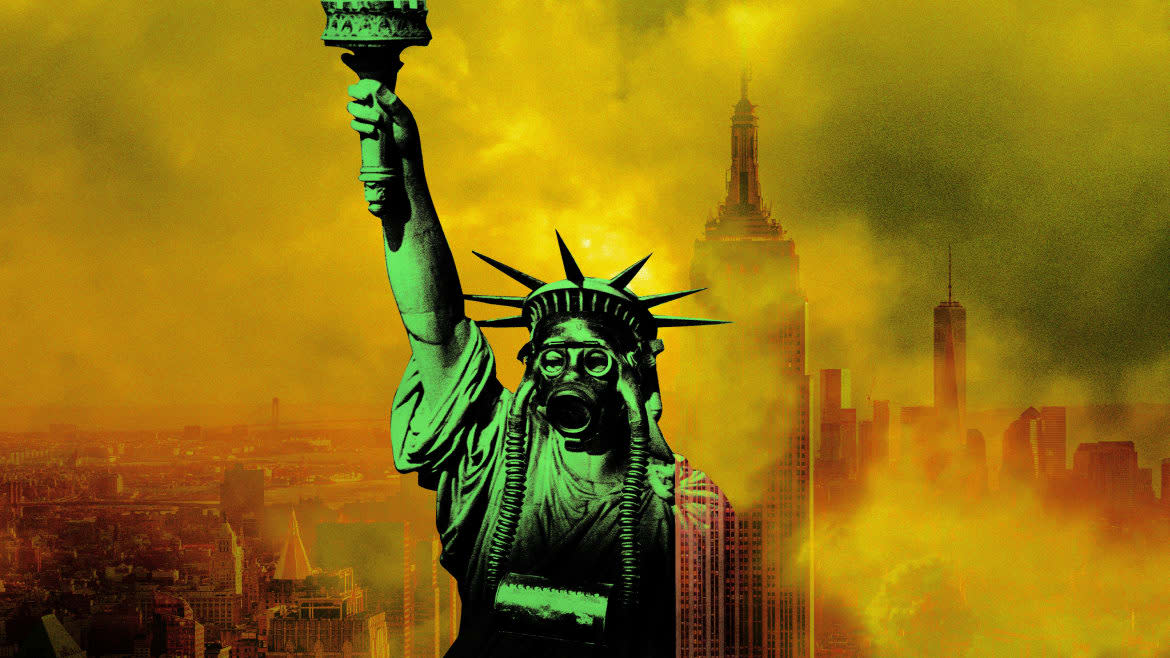
Have you noticed it’s a little cloudier than usual? You’re not alone. More than 400 wildfires in Canada have resulted in large swaths of the Northeastern U.S. to be enveloped in a thick blanket of smoke. It’s gotten so bad that the IQAir World Air Quality Index rated New York City’s air quality worse than any other city in the country on Tuesday.
“It’s common for air from Canada to reach the U.S.—winds don’t care about country boundaries,” Shantanu Jathar, a mechanical engineer at the Laboratory for Air Quality Research at Colorado State University, told The Daily Beast in an email. A spike in fires will naturally produce a ton of smoke that makes its way down to the U.S.
And that means significant health concerns for American residents. So much so that officials have recommended that older and at-risk New Yorkers stay inside and wear masks as they expect the smoke to remain for days.
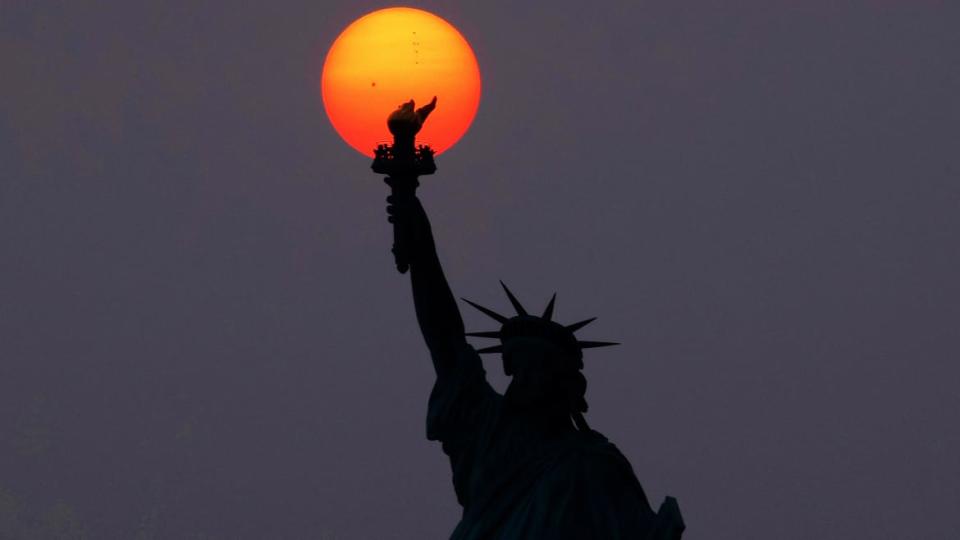
The sun is shrouded as it sets behind the Statue of Liberty in a hazy sky caused by smoke drifting into the Northeast of the U.S. from wildfires in Canada on May 22, 2023, in New York City.
New York is not alone. Major metropolitan areas in the U.S. including Minneapolis, Washington D.C., Baltimore, Philadelphia, and even cities down in the Carolinas have been impacted by the smoke. Meanwhile, Canadian provinces Quebec and Ontario have seen their air quality plummet to dangerous levels as well.
As the wildfires continue to spiral out of control, there’s a good chance that the situation grows worse before it gets better. With rising global temperatures due to anthropogenic climate change, you can bet that we’ll see a lot more of these issues crop up in the future.
So, to that end, here are a few best practices to keep in mind in our new hellish smokey apocalypse.
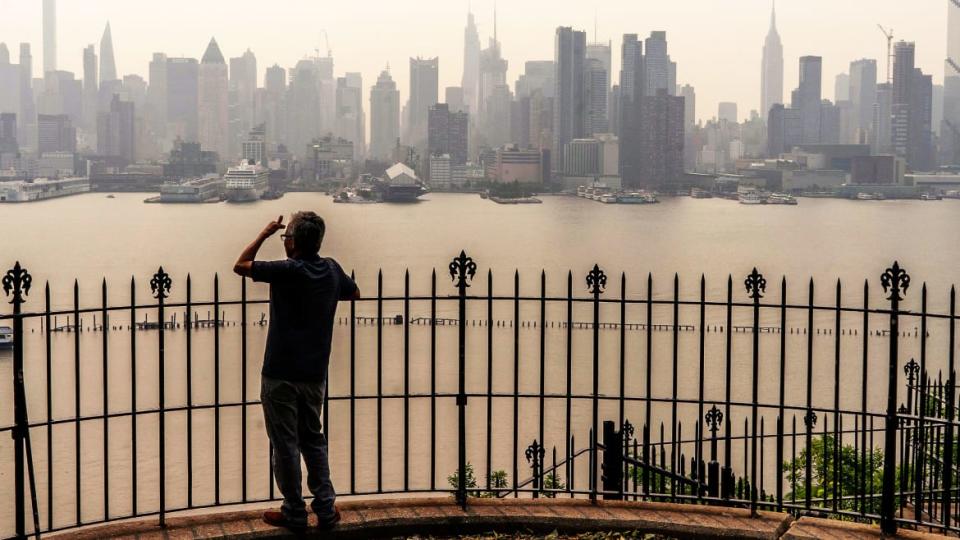
A person looks out at the New York City skyline as its covered with haze and smoke from Canada wildfires on June 7, 2023 in Weehawken, New Jersey. Air pollution alerts were issued across the United States due to smoke from wildfires that have been burning in Canada for weeks.
Mask Up
Deadly airborne particles that threaten your health? You know what that means: It’s time to break out those COVID masks (you do still have them, right?).
As we’ve learned from the pandemic, though, not all masks offer the same amount of protection. That means bandanas, dust masks, and even surgical masks won’t be enough to do the trick.
Experts recommend that if you’re in an area of the country with dangerous amounts of smoke affecting air quality, you should opt for an N95 mask if you can since they’re capable of filtering particles as small as 0.3 microns. (For reference comparison, a smoke particle from the wildfires is roughly 2.5 microns. The width of a strand of human hair is roughly 60 microns.)
“Wildfire smoke contains tiny particles—smaller than a tenth of the size of a human hair—which when they deposit in our airways can lead to respiratory and cardiovascular problems,” Jathar explained. “Children, older folks, and those with existing respiratory problems are the most susceptible.”
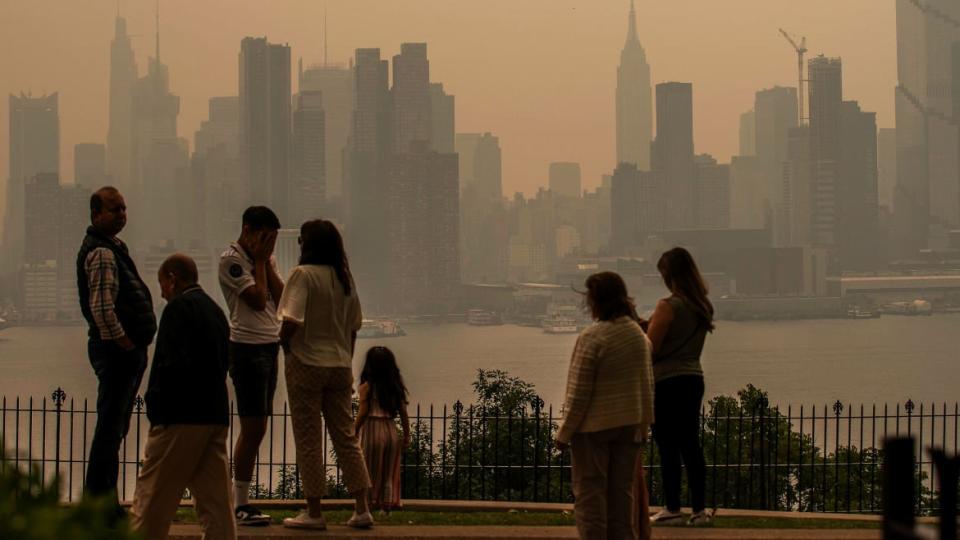
People stand in a park as the New York City skyline is covered with haze and smoke from Canada wildfires on June 7, 2023 in Weehawken, New Jersey. Air pollution alerts were issued across the United States due to smoke from wildfires that have been burning in Canada for weeks.
Stay Inside—Especially at Night
Both indoor and outdoor air quality drops at night. That’s because of a phenomenon known as temperature inversion. When temperatures cool down at night, the atmosphere essentially pulls any carbon dioxide emissions and other pollutants like wildfire smoke closer to the ground. Since it's less windy at night, too, this means that the air is still—further exacerbating issues.
So, when the sun starts to go down and you feel the temperature dropping, it’s best to head to an indoor space. While you’re inside, be sure to keep the windows closed and that the area is well-ventilated to make sure any bad air gets filtered out and good air gets filtered in. (More on that in a bit.)
If the air quality is especially bad in your area, it’s best to limit non-essential travel completely. Work from home if you can. Leave the house only for groceries and medical attention. Again, you should have plenty of practice with this because of the pandemic.
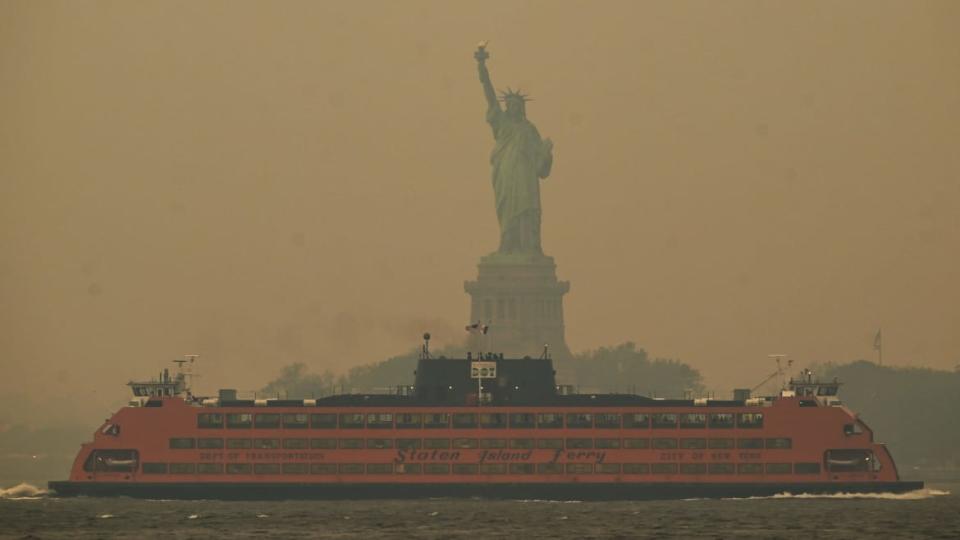
The Downtown Manhattan skyline stands shrouded in a reddish haze as a result of Canadian wildfires on June 06, 2023 in New York City. Over 100 wildfires are burning in the Canadian province of Nova Scotia and Quebec resulting in air quality health alerts for the Adirondacks, Eastern Lake Ontario, Central New York and Western New York.
Ventilate Your Home
There are numerous ways in which wildfire smoke outside can enter your house including through open doors and windows, and HVAC systems that draw in fresh air. So the most immediate thing you can do is make sure that all of your doors and windows are completely shut. This will keep natural ventilation from allowing bad air to come inside.
If you can control your home’s HVAC system, find out if it has fresh air intake. If it does, there’s often ways you can close it or change your system to recirculate the air that’s inside.
If you use an air conditioner that’s a window unit, close the outdoor air damper or consider turning the whole thing off and using a fan. You should definitely consider the latter if you use a portable AC unit that uses a hose.
Don’t worry about the air that’s circulating inside your house. There are ways that you can ensure that it’s clean.
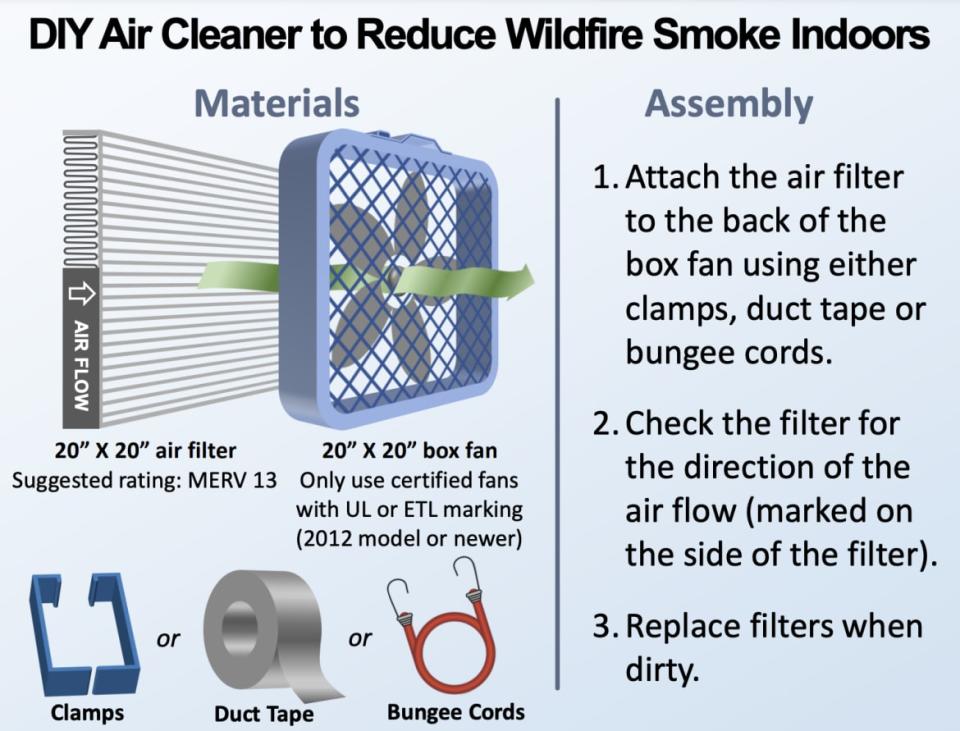
Get an Air Purifier (Or Make One Yourself)
An indoor air purifier is a portable machine that can reduce the amount of harmful particles in the air of a room. It’s a good device to have in places where people in your household might spend a lot of time such as an office, bedroom, or children’s play area.
Specifically, you’ll want to find one that’s a HEPA [high efficiency particulate air] purifying device. This will be able to remove roughly 99.9 percent of “dust, pollen, mold, bacteria, and any airborne particles with a size of 0.3 microns,” according to the U.S. Environmental Protection Agency.
Of course, this will likely be an incredibly hot commodity as the wildfire smoke continues to blanket the U.S. and Canada. Luckily, you can just make your own with a few items:
A 20” x 20” air filter with a MERV 13 rating
A 20” x 20” box fan
Something to attach the filter to the fan (e.g. duct tape)
Attach the filter to the back of the box fan (using the markings on the filter for the direction of airflow). Then replace the filters as they get dirtied up by the smoke in the air and marvel at how much poison you’re not breathing in.
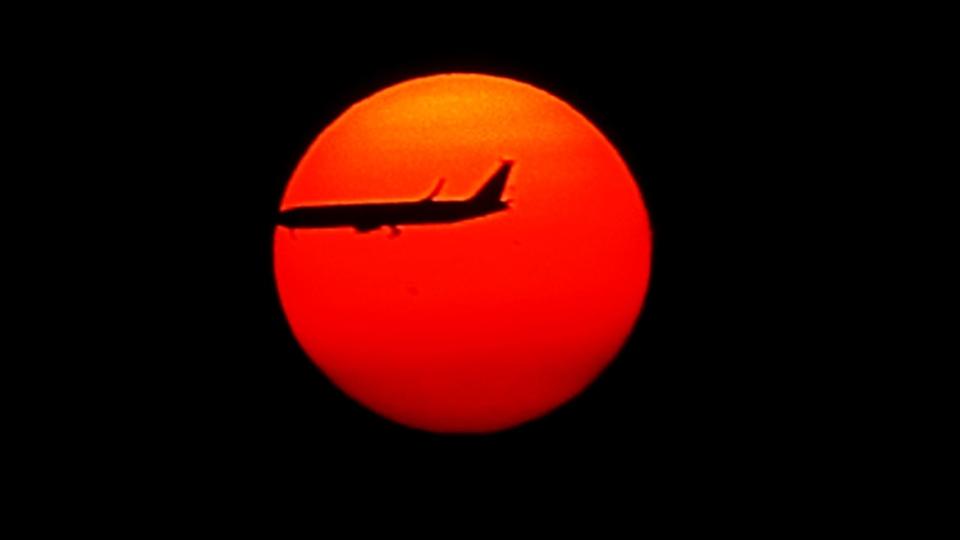
Wildfires in eastern Canada blows haze over New York City, United States and creates redder sunset on May 31, 2023. Because of affecting air quality in major US cities, Code Orange Air Quality Alert has been issued for parts of the Tri-State area starting with New Jersey.
Take a Break from Exercise
Don’t lace up those running shoes; marathon training can wait—especially when the outdoors is looking like one of the circles of Hell.
A study from February 2022 published in International Journal of Environmental Research and Public Health found that major sports teams perform much worse in areas with poor air quality. A 2021 study from the European Heart Journal found that exercise in areas with high air pollution has a profoundly negative impact on people’s cardiovascular health.
The NYC running club New York Road Runners even canceled its Global Running Day events on Wednesday in the wake of the dangerous levels of smoke that have permeated throughout the city. “If you’re in NYC or any affected area, please follow your city’s health advisory regarding air quality for June 7, and consider running another day,” the club warned on its website.
“Air quality is an important risk factor for human and animal health; think respiratory and cardiovascular diseases,” Jathar said. “Increased frequency, higher intensity, and a longer season for wildfires will continue to make wildfires an important source of poor air quality in the future.”
New U.N. Report Is Most Radical Call Yet for Climate Justice
Overthrow the Greedy Corporate Hegemony That Allowed This to Happen in the First Pla—Um, Call Your Representative
Perhaps the most impactful thing that we can do as citizens to prevent issues like this from happening in the first place is to encourage our elected officials to enact sound environmental policies that heavily regulate industries that exacerbate the causes of wildfires—and punish those that start them.
Greenhouse gas emissions increase global temperatures, resulting in drier climates that are more susceptible to wildfires. Even deforestation can inadvertently cause fires to rage out of control due to the lack of moisture in the soil, trees, and other vegetation in forested areas.
So, if we want a less smoky Big Apple in the future, we need to work towards solutions that also fight climate change. Hopefully, our elected leaders will be able to do their part in this effort. That would certainly be a breath of fresh air.
Get the Daily Beast's biggest scoops and scandals delivered right to your inbox. Sign up now.
Stay informed and gain unlimited access to the Daily Beast's unmatched reporting. Subscribe now.

